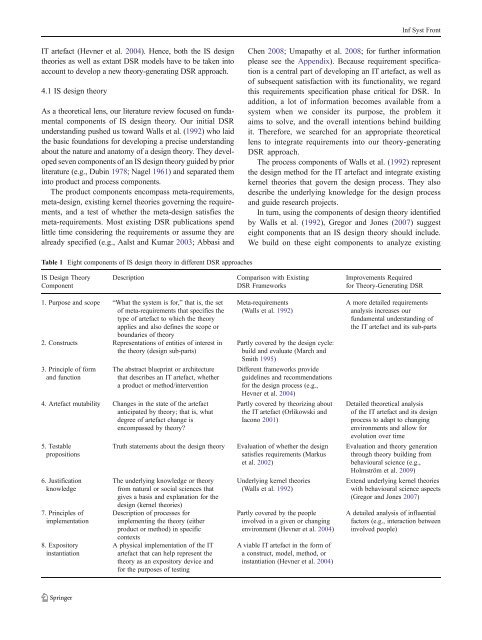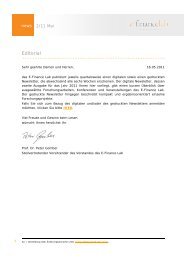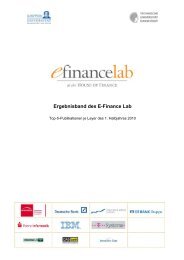Prof. Dr. Wolfgang König, Prof. Dr.-Ing. Ralf ... - E-Finance Lab
Prof. Dr. Wolfgang König, Prof. Dr.-Ing. Ralf ... - E-Finance Lab
Prof. Dr. Wolfgang König, Prof. Dr.-Ing. Ralf ... - E-Finance Lab
You also want an ePaper? Increase the reach of your titles
YUMPU automatically turns print PDFs into web optimized ePapers that Google loves.
IT artefact (Hevner et al. 2004). Hence, both the IS design<br />
theories as well as extant DSR models have to be taken into<br />
account to develop a new theory-generating DSR approach.<br />
4.1 IS design theory<br />
As a theoretical lens, our literature review focused on fundamental<br />
components of IS design theory. Our initial DSR<br />
understanding pushed us toward Walls et al. (1992) who laid<br />
the basic foundations for developing a precise understanding<br />
about the nature and anatomy of a design theory. They developed<br />
seven components of an IS design theory guided by prior<br />
literature (e.g., Dubin 1978; Nagel1961) and separated them<br />
into product and process components.<br />
The product components encompass meta-requirements,<br />
meta-design, existing kernel theories governing the requirements,<br />
and a test of whether the meta-design satisfies the<br />
meta-requirements. Most existing DSR publications spend<br />
little time considering the requirements or assume they are<br />
already specified (e.g., Aalst and Kumar 2003; Abbasi and<br />
Table 1 Eight components of IS design theory in different DSR approaches<br />
IS Design Theory<br />
Component<br />
Description Comparison with Existing<br />
DSR Frameworks<br />
1. Purpose and scope “What the system is for,” that is, the set<br />
of meta-requirements that specifies the<br />
type of artefact to which the theory<br />
applies and also defines the scope or<br />
boundaries of theory<br />
2. Constructs Representations of entities of interest in<br />
the theory (design sub-parts)<br />
3. Principle of form<br />
and function<br />
The abstract blueprint or architecture<br />
that describes an IT artefact, whether<br />
a product or method/intervention<br />
4. Artefact mutability Changes in the state of the artefact<br />
anticipated by theory; that is, what<br />
degree of artefact change is<br />
encompassed by theory?<br />
5. Testable<br />
propositions<br />
6. Justification<br />
knowledge<br />
7. Principles of<br />
implementation<br />
8. Expository<br />
instantiation<br />
Chen 2008; Umapathy et al. 2008; for further information<br />
please see the Appendix). Because requirement specification<br />
is a central part of developing an IT artefact, as well as<br />
of subsequent satisfaction with its functionality, we regard<br />
this requirements specification phase critical for DSR. In<br />
addition, a lot of information becomes available from a<br />
system when we consider its purpose, the problem it<br />
aims to solve, and the overall intentions behind building<br />
it. Therefore, we searched for an appropriate theoretical<br />
lens to integrate requirements into our theory-generating<br />
DSR approach.<br />
The process components of Walls et al. (1992) represent<br />
the design method for the IT artefact and integrate existing<br />
kernel theories that govern the design process. They also<br />
describe the underlying knowledge for the design process<br />
and guide research projects.<br />
In turn, using the components of design theory identified<br />
by Walls et al. (1992), Gregor and Jones (2007) suggest<br />
eight components that an IS design theory should include.<br />
We build on these eight components to analyze existing<br />
Meta-requirements<br />
(Walls et al. 1992)<br />
Partly covered by the design cycle:<br />
build and evaluate (March and<br />
Smith 1995)<br />
Different frameworks provide<br />
guidelines and recommendations<br />
for the design process (e.g.,<br />
Hevner et al. 2004)<br />
Partly covered by theorizing about<br />
the IT artefact (Orlikowski and<br />
Iacono 2001)<br />
Truth statements about the design theory Evaluation of whether the design<br />
satisfies requirements (Markus<br />
et al. 2002)<br />
The underlying knowledge or theory<br />
from natural or social sciences that<br />
gives a basis and explanation for the<br />
design (kernel theories)<br />
Description of processes for<br />
implementing the theory (either<br />
product or method) in specific<br />
contexts<br />
A physical implementation of the IT<br />
artefact that can help represent the<br />
theory as an expository device and<br />
for the purposes of testing<br />
Underlying kernel theories<br />
(Walls et al. 1992)<br />
Partly covered by the people<br />
involved in a given or changing<br />
environment (Hevner et al. 2004)<br />
A viable IT artefact in the form of<br />
a construct, model, method, or<br />
instantiation (Hevner et al. 2004)<br />
Inf Syst Front<br />
Improvements Required<br />
for Theory-Generating DSR<br />
A more detailed requirements<br />
analysis increases our<br />
fundamental understanding of<br />
the IT artefact and its sub-parts<br />
Detailed theoretical analysis<br />
of the IT artefact and its design<br />
process to adapt to changing<br />
environments and allow for<br />
evolution over time<br />
Evaluation and theory generation<br />
through theory building from<br />
behavioural science (e.g.,<br />
Holmström et al. 2009)<br />
Extend underlying kernel theories<br />
with behavioural science aspects<br />
(Gregor and Jones 2007)<br />
A detailed analysis of influential<br />
factors (e.g., interaction between<br />
involved people)








